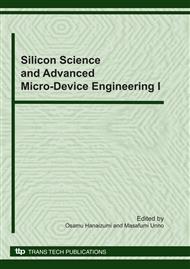p.140
p.145
p.153
p.157
p.162
p.168
p.173
p.179
p.183
Theoretical Analysis of Photonic Band Gaps and Defect Modes of Novel Photonic Crystal Waveguides Consisting of Si-Ion Implanted SiO2 Using the Finite-Difference Time-Domain Method
Abstract:
In this paper, photonic crystals (PC) based on 2-D periodic arrays of air holes were investigated on Si-ion implanted SiO2 using finite-difference time-domain (FDTD) simulations. The PC design parameters based on the telecommunication wavelength (λ=1.55 µm) were obtained by varying the radius to lattice constant ratio (r/a) from 0.2 to 0.45. We analyzed both transverse electric (TE) and transverse magnetic (TM) mode propagation in triangular-lattice PCs. The result obtained shows that a PC bandgap (PBG) exists for TE-mode propagation in the Si-ion implanted SiO2 patterned 2-D triangular lattice of air holes. We have also calculated the dispersion relations for the TE mode of a line defect in the structure and shown a fabricated sample. These analyses are obviously important for fabricating novel PC waveguides, which can easily be integrated into the existing silicon technology for directing light from one part of a chip to the other.
Info:
Periodical:
Pages:
162-167
Citation:
Online since:
December 2010
Price:
Сopyright:
© 2011 Trans Tech Publications Ltd. All Rights Reserved
Share:
Citation:


